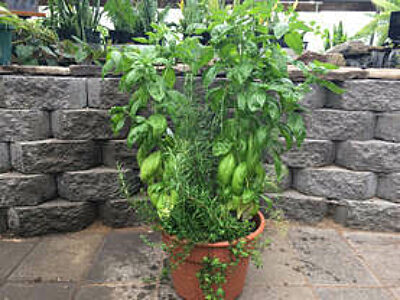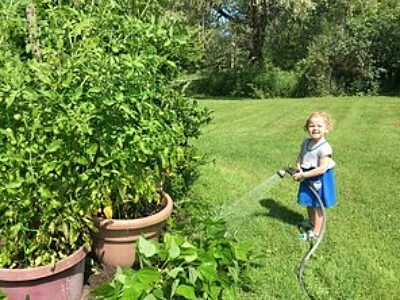Container gardening has been growing in popularity in recent years. Container gardening is the solution for urban and suburban dwellers with only a balcony or patio. It is also perfect for gardeners who have difficulty with mobility and traditional “hands and knees” gardening.
Soil is the key. Choosing the correct soil for your plants will help them thrive. Soil from the garden or bagged topsoil is much too heavy. Potted plants prefer a light, fluffy mix that is well aerated and drains well.

Potting mix with equal parts peat moss, perlite, and vermiculite is a great way to start. Some brands even come with fertilizer mixed in, resulting in a successful first growing season. Use new soil each season to reduce problems with disease.
Select a container that has space for roots to grow and drainage holes in the bottom. Both are critical as plants that are too crowded will dry out faster and become root bound. Your container should be about as large as you expect the mature plant’s foliage to spread. Many sizes, colors, and materials are available at stores, or you can upcycle unique containers from your garage, thrift store, or flea market.
Consistent watering is crucial. Smaller pots and those made of terra cotta will dry out more quickly and need water more often. One sunny day with heavy wind or a weekend away without watering can kill your hanging baskets. Newly planted pots will dry out more quickly until the roots fill the soil area. Early morning or evening when temperatures are cooler allow for better absorption, but if your plants are wilted, it’s still better to water ASAP. With constant watering, however, comes depletion of the nutrients in the soil. Water soluble fertilizers such as Miracle-Gro work great, although I prefer Espoma organic fertilizer.

Containers allow access to fresh herbs and vegetables right outside your kitchen door. Most vegetables require 6 hours of direct sunlight to thrive. Many root vegetables are suitable for containers: beets, carrots, onions, radishes, parsnips, potatoes, and sweet potatoes can all be grown successfully in pots. Leafy greens like lettuce and others do very well in containers. Use successive plantings to harvest all summer long. Many leafy greens can take a few hours of shade as well. Plant cool weather plants like spinach, kale, and arugula in April and September. Tomatoes, cucumbers, and peppers can also do well in large containers. Tomatoes need at least a 5-gallon pot to support their heavy stems and fruit, although there are some smaller patio varieties available. Peppers are wind pollinated so you will need to have several pots close together or pollinate by hand with a small paintbrush. I normally plant 3-4 peppers in each 14” pot in my container vegetable garden. I grow one large 16” pot of cucumbers with 4 plants each season using a tomato cage for them to climb.
Many herbs have different moisture needs, so grow them in separate pots. Basil is a warm weather annual that needs lots of sun and frequent harvesting to thrive -- remember to remove the flowers as they start to form. Rosemary grows well in pots, and since it’s not cold hardy in NY, you can bring the pot inside in the fall. Just remember that it does not like to be too wet. I grow 5 or 6 varieties of mint in pots around my patio, mulching them for the winter so they return the following year.
Pots of flowering annuals can provide splashes of color around your home. Give careful consideration to the amount of sun/shade they will receive. Color harmony is important in creating an eye appealing arrangement. For example, pastel pinks can accentuate the bold fuchsia-hot pink shades. Complementary colors planted together, such as blue and orange or yellow and purple, are also a great choice. Try to stick to two or three colors in one pot: too many colors are overwhelming. Larger containers look good with a taller focal plant in the center surrounded by colorful blooms and trailing varieties around the edges.
Let this be the year you begin to grow. Don’t let the lack of space or physical limitations rob you of the joy of gardening.
